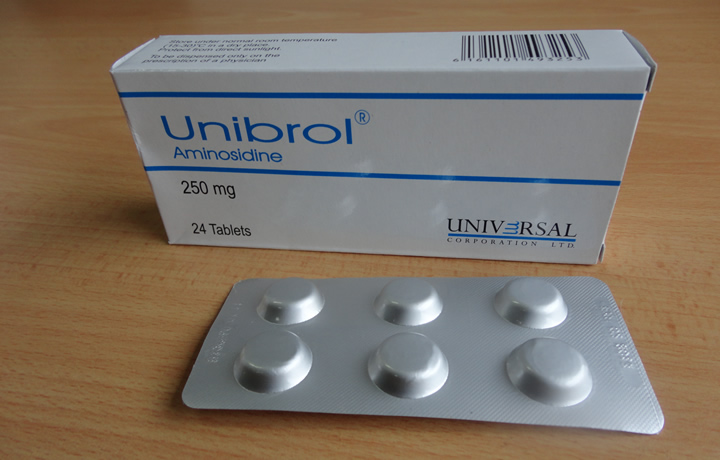
Unibrol Leaflet
Composition:
- Unibrol syrup: Each 5ml contains 125mg aminosidine U.S.P (as sulphate).
- Unibrol tablet: Each tablet contains 250mg aminosidine U.S.P (as sulphate).
Clinical pharmacology:
Aminosidine is active against various protozoa including: Leishmania spp; Entamoeba histolytica, and Cryptosporidium spp. In addition, it has an antibacterial spectrum similar to that of neomycin. It is active against many strains of gram-negative bacteria including species of Brucella, Calymmatobacterium, Campylobacter, Citrobacter, Escherichia, Enterobacter, Klebsiella, proteus, Serratia Vibrio and Yersinia. Aminosidine has been reported to be active against Mycobacterium tuberculosis but lacks activity against Pseudomonas aeruginosa.
Pharmacokinetics:
Aminosidine is poorly absorbed from the gastrointestinal tract and most of the dose is eliminated unchanged in the faeces.
Adverse-effects:
Includes: Nausea, vomiting, and diarrhoea. Prolonged oral therapy may cause a malabsorption syndrome with steatorrhea and diarrhea which can be very severe; supra-infection may occur, especially with prolonged oral treatment.
Precautions:
Aminosidine is contraindicated for intestinal disinfection when an obstruction is present and in patients with a known history of allergy to aminoglycosides. It should be used with great care in patients with kidney or liver disease or neuromuscular disorders and those with impaired hearing.
Drug interactions:
- Absorption following oral administration may be sufficient to produce interactions with other drugs administered systemically.
- Aminosidine taken by mouth, may impair the absorption of other drugs including Phenoxymethylpenicillin, Digoxin, Methotrexate, and some vitamins; the efficacy of oral contraceptives might be reduced. Aminosidine may enhance the effects of Acarbose.
Indications:
Aminosidine (paromomycin) is an aminoglycoside antibiotic that has been administered by mouth as sulphate in the treatment of intestinal protozoal infection including amoebiasis, cryptosporidiosis, and giardiasis. It has also been tried parenterally for visceral and topically for cutaneous leishmaniasis. Aminosidine may also be used for the treatment of tapeworm infection, but it is not the treatment of choice. Similarly to Neomycin, Aminosidine has been used in the suppression of intestinal flora both preoperatively and in the management of hepatic encephalopathy.
Dosage:
For Amoebiasis, Lambliasis, cryptosporidiosis and trichomoniasis:
Adult: 500mg twice per day for 6 days.
Children: 15mg/kg/day for 6 days.
For prophylactic sterilization in gastrointestinal Surgery:
-Adult:2gm daily for 3 days.
– Children 50mg/kg/day for 3days.
In taeniasis and other tapeworm infections: a dose of 4gm is given by mouth as a single dose or in divided doses over the course of one hour.
For hepatic encephalopathy: 4gm is given daily by mouth in divided doses at regular intervals for 5 to 6 days.
Presentation:
Syrup: 60ml and 100ml in amber coloured glass / PET bottles.
Tablets: Blister pack of 12’s.and 24’s in unit boxes.
Storage:
Do not store above 30°C. Store in a dry place. Protect from direct sunlight. Keep medicine out of reach of children.